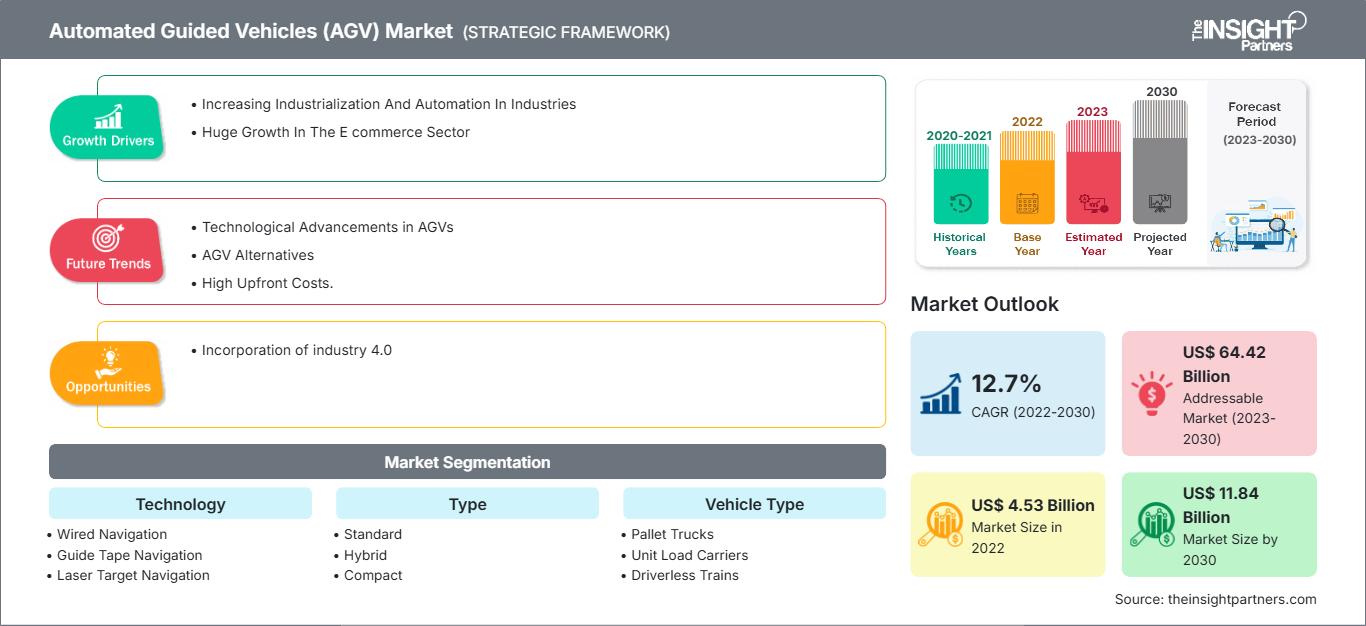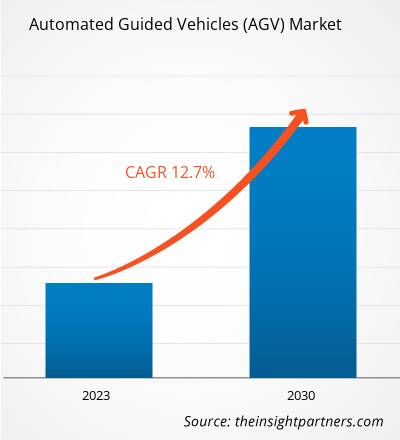[研究报告] 自动导引车 (AGV) 市场规模预计将从 2022 年的 45.3 亿美元增至 2030 年的 118.4 亿美元,预计 2022 年至 2030 年的复合年增长率为 12.7%。
分析师观点:
推动自动导引车 (AGV) 市场发展的关键因素之一是自动化和工业 4.0 的持续变革。随着各行各业拥抱数字化和智能制造流程,将 AGV 集成到现有系统中成为优化生产和物流工作流程的合理步骤。AGV 可以与其他机械和软件系统无缝连接,实现同步和精简的操作,从而提高生产力和吞吐量。工业 4.0 还旨在创建一个人机能够在仓库中高效协作的运营环境。例如,德国邮政 DHL 集团旗下的合同物流领导者 DHL 供应链在其仓库中使用 AGV 和机器人进行拣选。该公司与荷兰工业自动化公司 Robomotive 合作开发了一个能够完成卸垛、拣选和订单履行功能的机器人单元。多样化的产品目录、有竞争力的价格和购物便利性等因素大大提升了电子商务在消费者中的吸引力。由于亚马逊和沃尔玛等几家大型企业的进驻,电子商务在发达国家和新兴国家都发展迅速。电子商务的日益普及导致对仓库和配送中心的需求激增。因此,对电子商务零售的不断增长的需求进一步推动了自动导引车 (AGV) 市场的增长。
自动导引车 (AGV) 市场概览:
由于技术的不断进步以及对高效且经济的物料搬运解决方案的需求不断增长,自动导引车 (AGV) 市场正在经历显著增长。自动导引车 (AGV) 是一种自主操作的无人驾驶车辆,可在工业和商业环境中导航和运输物料,从而消除了对人工的需求并减少了人为错误。推动自动导引车 (AGV) 市场增长的另一个因素是各行各业对安全性和效率的日益重视。AGV 配备了先进的传感器、摄像头和防撞技术,使其能够在复杂环境中安全行驶,不会发生事故或损坏货物。这些特性使 AGV 成为寻求提高安全标准的行业的理想选择。
自动导引车 (AGV) 市场驱动力:
工业化和自动化程度的提高推动自动导引车 (AGV) 市场
工业化和自动化正在彻底改变全球企业和行业的运营方式。自动化通过减少劳动密集型任务并提高生产精度和速度,使企业能够提高成本效益和效率。自动化还具有提高产品质量和减少人为错误的潜力。它使企业能够改善客户服务、实现运营现代化并减少客户等待时间。自动化还帮助企业提高灵活性,使其能够快速响应市场变化。随着企业采用自动化,他们很快意识到自动化可以为运营带来的好处。工业化和自动化在各行各业正在显著发展。例如,罗克韦尔自动化在 2023 年 6 月宣布,由于技术应用,85% 的汽车制造商计划维持甚至增加员工队伍。此外,64% 的企业使用软件实现流程自动化,54% 的领导者正在提高自动化程度以解决劳动力短缺问题。自动导引车 (AGV) 被广泛用于多种用途:提高安全性、缩短生产时间、确保高产量以及最大限度地降低人为失误的风险。因此,工业化和自动化的不断发展推动了自动导引车 (AGV) 市场的发展。
自定义此报告以满足您的要求
您将免费获得任何报告的定制,包括本报告的部分内容,或国家级分析、Excel 数据包,以及为初创企业和大学提供超值优惠和折扣
自动导引车(AGV)市场: 战略洞察

- 获取本报告的主要市场趋势。这个免费样本将包括数据分析,从市场趋势到估计和预测。
您将免费获得任何报告的定制,包括本报告的部分内容,或国家级分析、Excel 数据包,以及为初创企业和大学提供超值优惠和折扣
自动导引车(AGV)市场: 战略洞察

- 获取本报告的主要市场趋势。这个免费样本将包括数据分析,从市场趋势到估计和预测。
报告细分和范围:
“自动导引车 (AGV) 市场”根据技术、车辆类型、最终用户和地理位置进行细分。根据技术,自动导引车 (AGV) 市场分为激光目标导航、磁导航、有线导航、导带导航和其他。根据车辆类型,自动导引车 (AGV) 市场分为牵引车、托盘搬运车、拖车、叉车和其他。根据最终用户,自动导引车 (AGV) 市场分为物流、汽车、一般制造、医疗保健、零售、食品和饮料、航空航天和其他。根据地理位置,自动导引车 (AGV) 市场分为北美、欧洲、亚太地区、中东和非洲和南美洲。
自动导引车 (AGV) 市场细分分析:
根据技术,自动导引车 (AGV) 市场细分为有线导航、导带导航、激光目标导航、磁力导航等。激光目标导航细分市场在 2022 年占据最大份额。预计在预测期内,该细分市场将在自动导引车 (AGV) 市场中实现最高的复合年增长率。自动导引车 (AGV) 的激光目标导航方法非常灵活,可用于各种环境。反射目标可以放置在地板、墙壁或其他表面上,以便 AGV 可以绕过障碍物并穿过狭窄的过道。激光目标导航可以扩展以适应各种 AGV,从小型推车到大型叉车。这使其成为各种仓库和制造应用的多功能解决方案。各大制造商都推出了配备激光目标导航系统的自动导引车。
自动导引车 (AGV) 市场区域分析:
2022 年北美自动导引车 (AGV) 规模为 11.6116 亿美元,预计到 2030 年将达到 29.769 亿美元;预计 2023 年至 2030 年期间的复合年增长率为 12.5%。北美自动导引车 (AGV) 市场分为美国、加拿大和墨西哥。2022 年,美国占据北美自动导引车 (AGV) 市场的最大份额。美国制造企业计划在未来几年通过采用新技术来提高生产力,从而实现快速增长。此外,天然气价格下降、新兴市场劳动力成本上升以及更好的保护公司知识产权的监管框架促进了它们的增长。美国企业正在部署自动化物料搬运解决方案,以提高生产力并在其服务的市场中获得竞争优势。金属、食品和饮料、仓储、生命科学以及半导体和电子制造行业的企业越来越多地在其设施中部署自动化物料搬运设备。新的电动汽车或自动驾驶汽车制造商正在美国开设制造工厂。
自动导引车 (AGV) 市场主要参与者分析:
自动导引车 (AGV) 市场由 Dematic Corp、Kion Group AG、Jungheinrich AG、Toyota Material Handling Inc、Konecranes Plc、John Bean Technologies Corp、Daifuku Co Ltd、Bastian Solutions LLC、Hyster-Yale Group Inc 和 Murata Machinery Ltd 等参与者组成。
自动导引车 (AGV) 市场区域洞察
The Insight Partners 的分析师已详尽阐述了预测期内影响自动导引车 (AGV) 市场的区域趋势和因素。本节还讨论了北美、欧洲、亚太地区、中东和非洲以及南美和中美洲的自动导引车 (AGV) 市场细分和地域分布。
自动导引车(AGV)市场报告范围
| 报告属性 | 细节 |
|---|---|
| 市场规模 2022 | US$ 4.53 Billion |
| 市场规模 2030 | US$ 11.84 Billion |
| 全球复合年增长率 (2022 - 2030) | 12.7% |
| 历史数据 | 2020-2021 |
| 预测期 | 2023-2030 |
| 涵盖的领域 |
By 技术
|
| 覆盖地区和国家 | 北美
|
| 市场领导者和主要公司简介 |
|
自动导引车 (AGV) 市场参与者密度:了解其对业务动态的影响
自动导引车 (AGV) 市场正在快速增长,这得益于终端用户需求的不断增长,而这些需求又源于消费者偏好的不断变化、技术进步以及对产品优势的认知度不断提升等因素。随着需求的增长,企业正在扩展产品线,不断创新以满足消费者需求,并抓住新兴趋势,从而进一步推动市场增长。

- 获取 自动导引车(AGV)市场 主要参与者概述
最新动态:
自动导引车 (AGV) 市场中的企业广泛采用并购等非自主和自主策略。以下列出了自动导引车 (AGV) 市场的一些最新关键动态:
- 2023 年 6 月,德马泰克 (Dematic) 推出了其最新的冷冻级自动导引车 (AGV)。德马泰克的全系列 AGV,包括高伸展和平衡重型号,均在澳大利亚设计和制造。这些 AGV 现已获得在冷冻条件下使用的全面认证,以满足不断增长的自动导引车 (AGV) 市场的需求。
- 2023 年 3 月,永恒力股份公司 (Jungheinrich AG) 成功从 Merit Capital Partners、MFG Partners 及其管理层手中收购了存储解决方案集团(简称“存储解决方案”)。所有交割要求,包括美国并购监管审批,均已满足。永恒力凭借存储解决方案,在美国拓展货架和仓库自动化市场,并奠定了坚实的增长基础。
- 2021年12月,凯傲集团在中国开设了一家新的叉车工厂,并为进一步建设供应链解决方案工厂奠定了基础。这些新工厂将助力凯傲集团推进其在华增长战略,并拓展其在两个运营领域的产品组合。凯傲集团计划在中期内在济南新增1000多个就业岗位。凯傲集团近4万名员工中,已有超过4600人在中国工作。
- 历史分析(2 年)、基准年、预测(7 年)及复合年增长率
- PEST和SWOT分析
- 市场规模、价值/数量 - 全球、区域、国家
- 行业和竞争格局
- Excel 数据集
近期报告
客户评价
购买理由
- 明智的决策
- 了解市场动态
- 竞争分析
- 客户洞察
- 市场预测
- 风险规避
- 战略规划
- 投资论证
- 识别新兴市场
- 优化营销策略
- 提升运营效率
- 顺应监管趋势




















 获取免费样品 - 自动导引车(AGV)市场
获取免费样品 - 自动导引车(AGV)市场